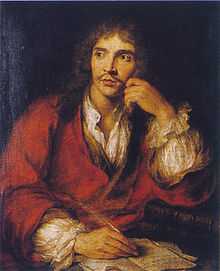Charles-Antoine Coypel

Charles-Antoine Coypel, self-portrait, 1734.

Charles-Antoine Coypel, Molière
Charles-Antoine Coypel (11 July 1694 – 15 June 1752) was a French painter, art commentator, and playwright. He lived in Paris.[1] He was the son of the artist Antoine Coypel and grandson of Noël Coypel. Charles-Antoine inherited his father’s design and painting duties as premier peintre du roi (First Painter to the King) at the French court when his father died in 1722. He became premier peintre du roi and director of the Académie Royale in 1747. He received a number of commissions for paintings for the Palais de Versailles, and worked for Madame de Pompadour, the king’s mistress.[2]
Coypel was an excellent tapestry designer. He designed tapestries for the Gobelins manufactory. His most successful tapestries were created from a series illustrating Don Quixote.[2] Coypel was the first to illustrate Don Quixote in a sophisticated manner. These illustrations were painted as cartoons for tapestries, and were engraved and published in a deluxe folio in Paris in 1724.[3] Coypel created twenty-eight small paintings for these tapestries over a number of years. Each of the paintings was used as the centrepiece of a larger area that was richly decorated with birds, small animals, and garlands of flowers on a pattered background. Over two hundred pieces of the Don Quixote series were woven between 1714 and 1794.[4] He received a commission to design a series of theatrical scenes for tapestries for the queen of Poland in 1747.[2] Coypel also wrote prose, several comedies, two tragedies, and some poetry.[2]
References
- ↑ Craske, Matthew, 1997, Art in Europe 1700-1830: A History of the Visual Arts in an Era of Unprecedented Urban Economic Growth, Oxford University Press, ISBN 0-19-284206-4, p. 145.
- ↑ 2.0 2.1 2.2 2.3 Charles-Antoine Coypel The Getty Museum.
- ↑ Paulson, Ronald, 1998, Don Quixote in England: The Aesthetics of Laughter, Johns Hopkins University Press, ISBN 0-8018-5695-7, p.45.
- ↑ Jenkins, D.T., 2003, The Cambridge History of Western Textiles, Cambridge University Press, ISBN 0-521-34107-8, p.612.

